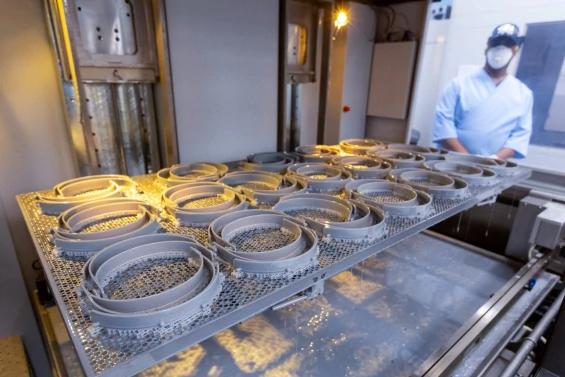3D Printed Medical Device Market Set to Skyrocket to $16.5 Billion by 2034
Soaring to $16.5 billion by 2034, the 3D printed medical device market is on a remarkable growth trajectory. According to a recent report by Additive Manufacturing Research titled “Market Trends and Opportunities in Medical Devices; Prosthetics, Dental, Audiology,” the market is expected to expand from $4.5 billion in 2023, achieving a compound annual growth rate (CAGR) of 12% over the next decade.
Transformative Impact
3D printing technology has revolutionized the healthcare sector, significantly impacting the production and accessibility of medical devices. This technology has helped create personalized medical devices tailored to individual patient needs, reducing development costs and fostering innovation in advanced medical solutions. For instance, custom-made implants and prosthetics, such as titanium implants for cranial reconstruction and personalized limb prosthetics, have improved patient outcomes and comfort.
Over the past two decades, 3D printing has not only improved patient outcomes but also made healthcare more accessible. In the dental industry, 3D printing allows for the quick production of crowns, bridges, and dentures with high precision, even enabling same-day service for patients. Custom-fit hearing aids and other audiology devices, like cochlear implants, have become more accurate and comfortable, enhancing the quality of life for people with hearing impairments. Additionally, surgeons now use 3D printed models and guides for pre-surgical planning, reducing errors and improving surgical outcomes.
During the years of the COVID-19 pandemic, 3D printing played a crucial role in addressing production challenges, streamlining supply chains, and bringing device design and production closer to patients and providers. The ability to quickly produce essential medical supplies, such as personal protective equipment (PPE) and ventilator components, proved how flexible and quick 3D printing could be.

General Motors workers 3D print face shields in 2020 in response to the COVID-19 pandemic. Image courtesy of Jeffrey Sauger/ General Motors.
As the industry moves forward, the integration of 3D printing technology is expected to drive significant growth, particularly in the fields of prosthetics, audiology, and dental care. Orthopedic solutions, including custom 3D printed braces, splints, and implants, are also becoming more important, offering better fit and functionality. Additionally, creating personalized drug delivery systems, like custom pills, makes treatments more effective and helps patients stick to their medication plans.
Key Findings
Building on this progress, the report highlights several critical trends and opportunities within the 3D printed medical device market. Continuous innovation in application-specific 3D printing platforms, especially within the dental sector, is a major driver of market growth. These technological advances are improving the precision and customization of medical devices, making them more effective and tailored to individual patient needs.
Another significant trend is the digitization of healthcare and medical device supply chains. This shift makes production processes more efficient and responsive, which is essential for keeping 3D printing adoption growing. By using digital tools and technologies, the healthcare industry can streamline operations and improve patient care.
Additionally, regulatory agencies like the U.S. Food and Drug Administration (FDA) and the European Medicines Agency (EMA) are gradually guiding 3D printing medical devices. This regulatory progress is key for broader acceptance and integration of 3D printed devices in healthcare. With clear guidelines and support from these agencies, manufacturers can develop and market innovative 3D printed solutions more confidently, ensuring they are safe and effective for patients.
Segmentation and Forecast
To delve deeper into the market dynamics, the report provides an in-depth analysis segmented by technology, material, and services. This segmentation helps identify specific areas of growth and opportunities for stakeholders in this growing 3D printing ecosystem. According to the data, services make up a significant portion of the market revenue, followed by materials and hardware.
According to the report, the projected market revenue for 3D printed medical devices from 2022 to 2034 shows a steady increase in market value, with total revenues expected to reach $16.5 billion by 2034. This growth is broken down into significant contributions from different segments, with services projected to generate $11.5 billion, materials contributing $3.7 billion, and hardware accounting for $1.3 billion. This upward trend stresses the growing importance and use of 3D printing technology in the medical device industry.

Total market revenue for 3D printed medical devices. Image courtesy of Additive Manufacturing Research.
The report also profiles key vendors in the 3D printing industry, including 3D Systems, Formlabs, Stratasys, and Materialise. These companies are at the forefront of innovation, providing the technologies and materials essential to moving the medical device sector forward.
As 3D printing technology continues to evolve, its application in the medical device industry is set to expand further. The prosthetics, audiology, and dental segments are expected to benefit significantly from this technology, leading to more personalized and effective medical solutions. The report anticipates that the ongoing advances in 3D printing platforms, combined with regulatory support and digitized supply chains, will continue to drive market growth.
For industry stakeholders, this report is an invaluable resource for understanding the market landscape and identifying potential growth areas. To explore these insights further and access the extensive data file with a ten-year revenue forecast segmented by technology, material, and services, visit Additive Manufacturing Research’s website and download a free sample of the report.
Subscribe to Our Email Newsletter
Stay up-to-date on all the latest news from the 3D printing industry and receive information and offers from third party vendors.
You May Also Like
The US Air Force: Kings of 3D Printing
The US Air Force is currently one of the largest funding bodies in 3D printing. The amount of work that the Air Force is doing in 3D printing is simply...
Xact Metal Unveils New Hardware and Alliance at RAPID+TCT 2024
At RAPID + TCT 2024 in Los Angeles, Xact Metal announced a partnership with Indicate Technologies to expand its reach in North America and introduce a new automated powder handling...
Bound Metal Firm AIM3D Relaunched with Replique and Create It Real as Partners
AIM3D has developed a series of machines capable of producing metal, polymer, and ceramic parts. Using its Voxelfill technique, which enhances Z-strength, the company also uses pellets, making its process...
HP Unveils Metal Jet Production Service, New 3D Printing Offerings at RAPID + TCT 2024
HP, maker of the Jet Fusion and Metal Jet S100 additive manufacturing (AM) ecosystems, has made some big announcements at RAPID + TCT 2024 in Los Angeles (June 25-27), where...


































